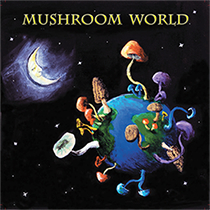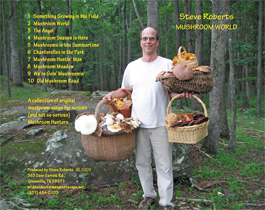Recently Published Reviews
 A review of Mushroom World written by David Rose and published in the Spring 2010 issue of Fungi Magazine
A review of Mushroom World written by David Rose and published in the Spring 2010 issue of Fungi Magazine
Exuberance is beauty said William Blake, and this charming collection of folk songs about mushrooms has both in full measure. Steve Roberts is the exuberant singer, guitarist, harmonica player, and composer whose rhapsody on the ways of mushroom hunting captures the intimate pleasures of the moment and the full beauty of the seasons. The title song, rooted in plaintive melody, is a down-home tribute to autumn where the circumambient tone of falling leaves, a hint of frost in the air, and fungal earthiness provoke memories of good times in the woods on the mushroom trail. Mushrooms are the common focus of all ten songs here, and the entire effect is to redirect the listener to that “other world” where the mushrooms are calling us. That other world may be a favorite bolete hunting spot, or it might just be a state of mind. In any case, here is a set of tunes whose populist vision of mushrooming is informed by long experience in mycology and music, and the result is utterly splendid.
Anyone who has had the great good fortune of hearing Steve Roberts perform at a foray knows firsthand his spirited musicianship. Like other singer/songwriters who have worked in the folk arena, he has covered a wide range of subjects from the meaning of home and family to political critique. Steve is a bluesy improviser and knowledgeable chronicler of song. In Mushroom World one hears elements of Bob Dylan, John Prine, James Taylor, and Neil Young, but these influences are all subtly intimated in eclectic settings. Steve has assimilated everything from Johnny Cash to the Feelies and made it his own – and he added the mushrooms! His accompanists, who include his wife Toni and their daughter Addie, achieve a perfect balance in a production whose clarity is sustained throughout.
Steve Roberts knows his mushrooms; in Mushroom World he proves that he also knows the kinds of folk who are crazy about them: myco-gypsies, Johnny Appleseed types, cock-eyed obsessives with toadstools in their beards. Where else will one hear a musical reference to Vibrissea truncorum (“I even found one growin’ in a stream”) but in the songs of an experienced mushroomer? The cautionary tale of Amanita virosa (“The Angel”) is catchy and compelling (“it’ll fry your liver!”), and “The Old Mushroom Road” finds violin and harmonica in delicate counterpoint to piano seeking out that melancholy moment that, deep down inside, all of us surely know. Here are exuberant songs that are kid-friendly, funny, and wholly original – a toe-tapping elegy to your favorite patch of mushrooms. Mushroom World is just what the world has been waiting for! The mushrooms rule and the music rocks!
David Rose is an accomplished freelance writer and contributing editor for FUNGI Magazine, published five times per year. David is best known for his regular column, Notes from the Underground. The above review appeared in Vol. 3, No.2, p. 40.
 A review of Mushroom World written by Leon Shernoff and published in the Spring 2009 issue of Mushroom, The Journal of Wild Mushrooming
A review of Mushroom World written by Leon Shernoff and published in the Spring 2009 issue of Mushroom, The Journal of Wild Mushrooming
After I began my review of Steve Roberts’ new album, Mushroom World, I paused to look back at my previous review of Roberts’ work, a Winter 2004 look at his album This Old Wooden Fence. That album divided its time between mushrooms, the outdoors in general, and protesting the policies of then-president Bush, especially the then-new wars in Iraq and Afghanistan (hard to believe we’ve been at them for so long). The current album, however, is all mushrooms, all the time. Presidents come and go, but fungi keep rollin’ along.
I see that in the earlier review I found the music to be sort of triangulating between mushrooms, John Denver and James Taylor; but this time I am going to firmly declare that Steve Roberts is the John Denver of mushroom-hunting. He brings to his work in exploring the mushroom-hunting experience a sense of dedication similar to the feeling Denver brings to chronicling the experiences of the countryside in general. Other similarities include the general harmonic language, acoustic band sound, and even a bit of the accent. Roberts’ work is also reminiscent of Denver in that he concentrates so firmly on the experience of ones surroundings, while Taylor is much more introspective.
This is conservative but not hackneyed music. It’s an issue that’s sometimes hard for me to judge, since I’m a composer who makes up my own harmonies and sometimes everything that uses traditional chords seems derivative to me. By the time we get to the end of a phrase on Mushroom World, I pretty much know what the chords are going to be, but they usually don’t arrive when I expected, or they have another chord or two thrown in between. So for me it does fly close to the ground, but never lands on the highway. Plus, how mainstream can a track be when it has lyrics like:
It’s the right time of the year
When the fruiting bodies start to appear
And the warm breeze begins to blow
Signs of fungus about to grow
Most of the tunes are fairly mellow, but “Mushroom Huntin’ Man” is sort of a faux gunslinger ballad about a Dan Tucker-like figure who has mushrooms growing in his beard and gets peppered with buckshot while hunting on a neighbor’s property. “The Angel,” an ominous song about deadly Amanitas, is another up-tempo number.
Those of you who’d like to preview or order individual tracks by themselves can do so at Steve’s web site: www.musicbysteveroberts.com. However, the CD box is one good reason to order the physical disk – it features attractive cover art by Samantha Carter, and a jealousy-inducing photo of Steve with brimming baskets of local mushrooms (and one of the baskets alone with his guitar).
Leon Shernoff, PhD is an author and musician with a doctorate in music, and is the editor and publisher of the quarterly magazine Mushroom, The Journal of Wild Mushrooming. The above review appeared in Issue 103, Vol. 27, No. 2, p. 32.

